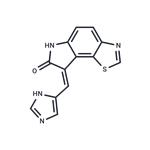Description
The activity of double-
stranded RNA-
activated protein kinase (PKR) is altered by viral infection as well as by various neuropathologies. A primary phosphorylation target of PKR is eukaryotic initiation factor 2 subunit α (eIF2α), blocking translation and driving apoptosis. PKR Inhibitor is an oxindole/imidazole derivative that binds the ATP-
binding site of PKR and blocks autophosphorylation with an IC
50 value of 186-
210 nM. PKR Inhibitor protects human neuroblastoma cells against cell damage triggered by tunicamycin-
mediated endoplasmic reticulum stress. It also prevents phosphorylation of Fas-
associated protein with a death domain (FADD) in neuroblastoma cells, preventing FADD-
dependent activation of caspases and apoptosis. Intraperitoneal administration of PKR inhibitor in rats reduces phosphorylation of PKR and eIF2α in the brain. Similar administration in mice enhances long-
term memory storage, including contextual and auditory long-
term fear memories.
Uses
PKR Inhibitor is a drug which acts as a selective inhibitor of the enzyme double-stranded RNA-dependent protein kinase (PKR). It has been shown to effectively inhibit PKR function in vivo and has neuroprotective and nootropic effects in animal studies.
Biochem/physiol Actions
Imidazolo-oxindole PKR inhibitor C16 is a selective inhibitor of RNA-dependent protein kinases (PKR, Eif2ak2). C16 is a first reported, potent and selective PKR inhibitor. Its inhibition effect on PKR is ATP-binding site directed. C16 specifically inhibits the apoptotic PKR/eIF2a signaling pathway without stimulating the proliferative mTOR/p70S6K signaling mechanism.
in vitro
pkr inhibitor was identified as a small molecule able to inhibit the autophosphorylation of pkr and to rescue the translation blockade induced by pkr. it was found that pkr inhibitor prevented not only pkr phosphorylation but also the activation of caspase 3 induced by ab in sh-sy5y cells. in addition, the protective effect of pkr inhibitor on the neuronal cell death induced by endoplasmic reticulum-stress in sh-sy5y cells has been reported [1].
in vivo
a previous animal study used an in-vivo model of 7-day-old rat exhibiting a high activation of brain pkr to investigate the effects of pkr inhibitor. results showed for the first time that acute systemic injection of pkr inhibitor could specifically inhibit the apoptotic pkr/eif2a signaling pathway without stimulating the proliferative mtor/p70s6k signaling mechanism [1].
References
1) Jammi et al. (2003), Small molecule inhibitors of the RNA-dependent protein kinase; Biochem. Biophys. Res. Commun., 308 50
2) Shimazawa et al. (2007), Involvement of double-stranded RNA-dependent protein kinase in ER stress-induced retinal neuron damage; Ophthalmol. Vis. Sci., 48 3729
3) Ingrand et al. (2007), The oxindole/imidazole derivative C16 reduces in vivo brain PKR activation; FEBS Lett. 581 4473
4) Tronel et al. (2014), The specific PKR inhibitor C16 prevents apoptosis and IL-1β production in an acute excitotoxic rat model with a neuroinflammatory component; Neurochem. Int. 64 73
5) Couturier et al. (2011) Prevention of the β-amyloid peptide-induced inflammatory process by inhibition of double-stranded RNA-dependent protein kinase in primary murine mixed co-cultures; Neuroinflammation, 8 72
![8-(1H-IMIDAZOL-4-YLMETHYLENE)-6,8-DIHYDRO-THIAZOLO[5,4-E]INDOL-7-ONE Structure](https://www.chemicalbook.com/CAS/GIF/608512-97-6.gif)


